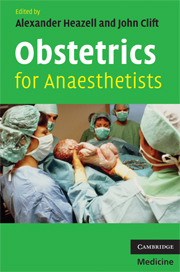Book contents
- Frontmatter
- Contents
- List of contributors
- Foreword
- Preface
- Acknowledgements
- List of abbreviations
- 1 Maternal physiology and obstetrics
- 2 Antenatal care
- 3 Induction of labour
- 4 Normal labour
- 5 Abnormal labour
- 6 Fetal monitoring
- 7 Pre-eclampsia and hypertensive disorders of pregnancy
- 8 Operative obstetrics
- 9 Obstetric haemorrhage
- 10 Thromboembolic disorders of pregnancy
- 11 Infection
- 12 Life support in obstetrics
- 13 Drugs in obstetrics
- 14 Confidential enquiries into fetal, neonatal and maternal death
- Appendix 1 Adult Advanced Life Support Algorithm
- Appendix 2 The Management of Postpartum Haemorrhage Algorithm
- Appendix 3 Emergency Management of Eclamptic Fit Algorithm
- Index
- References
7 - Pre-eclampsia and hypertensive disorders of pregnancy
Published online by Cambridge University Press: 21 August 2009
- Frontmatter
- Contents
- List of contributors
- Foreword
- Preface
- Acknowledgements
- List of abbreviations
- 1 Maternal physiology and obstetrics
- 2 Antenatal care
- 3 Induction of labour
- 4 Normal labour
- 5 Abnormal labour
- 6 Fetal monitoring
- 7 Pre-eclampsia and hypertensive disorders of pregnancy
- 8 Operative obstetrics
- 9 Obstetric haemorrhage
- 10 Thromboembolic disorders of pregnancy
- 11 Infection
- 12 Life support in obstetrics
- 13 Drugs in obstetrics
- 14 Confidential enquiries into fetal, neonatal and maternal death
- Appendix 1 Adult Advanced Life Support Algorithm
- Appendix 2 The Management of Postpartum Haemorrhage Algorithm
- Appendix 3 Emergency Management of Eclamptic Fit Algorithm
- Index
- References
Summary
Introduction
Pre-eclampsia is a multi-system disorder, which primarily affects the cardiovascular system, leading to dysfunction of liver, lungs, kidney and brain. Pre-eclampsia is unpredictable in presentation and progression. At present, there is no curative treatment for pre-eclampsia and the ultimate management is the delivery of the fetus and placenta. Pre-eclampsia can present at any time after the 20th week of gestation, and is an important cause of iatrogenic prematurity, with the associated perinatal morbidity and mortality. In cases of extreme prematurity, pregnancy is prolonged until maternal health is at risk. Success in the management of pre-eclampsia is dependent at least in part on a multidisciplinary approach by the midwifery, obstetric, anaesthetic, intensive care and neonatal teams.
In the UK, pre-eclampsia has an incidence of between 3% and 5%, with severe pre-eclampsia complicating 0.5% of pregnancies. Eclampsia affects only 0.05% of pregnancies in the UK. It is estimated that 1 in 6 stillbirths and 14% of maternal mortality are due to pre-eclampsia and hypertensive disorders of pregnancy.
Aetiology and pathogenesis
Pre-eclampsia is related to placental pathology, probably arising from decreased trophoblast invasion in the first trimester. This reduction in invasion fails to convert the convoluted spiral arteries to high-flow, low-resistance vessels that feed the placenta, thus decreasing placental blood flow, which may result in placental hypoxia and oxidative stress. It is hypothesised that the damaged placenta releases active factor(s) into the maternal circulation that results in endothelial damage and vasoconstriction within the maternal vasculature (Figure 7.1).
Keywords
- Type
- Chapter
- Information
- Obstetrics for Anaesthetists , pp. 70 - 87Publisher: Cambridge University PressPrint publication year: 2008

